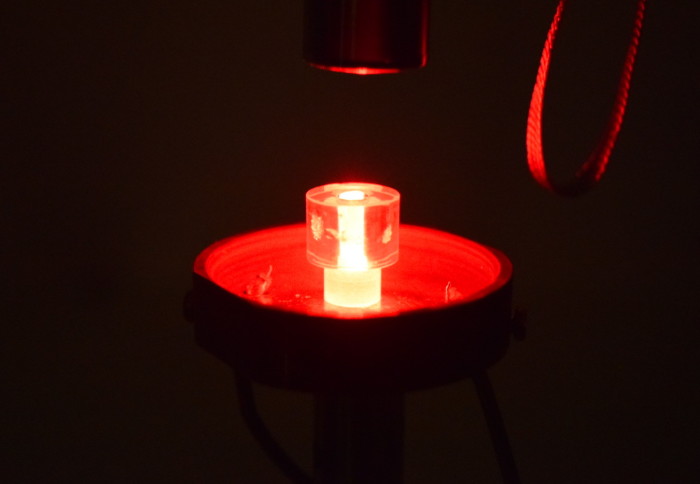Researchers find new MASER material that could revolutionise imaging and sensing

The 'DAP' maser crystal in its resonator illuminated with red light
Experts in the Department of Materials have found a new material that could redefine the use of room-temperature masers.
Masers, the microwave version of lasers, are devices with the remarkable ability to amplify even the weakest electrical signals and possess a high level of frequency stability. This makes them an ideal tool for applications such as medical sensors, GPS, and deep-space communication.
A maser works similarly to a laser by using the principle of stimulated emission, but instead with invisible microwave photons. For example, if you pass one photon through the molecules inside a maser, you will get two photons out. This builds up a chain reaction as each photon passes through more and more molecules in the material, generating an exponential number of photons along the way. Therefore, what was once one photon at the start is amplified into millions of photons at the end.
Until a research breakthrough in the Department of Materials in 2012, masers required cryogenic temperatures to operate. This breakthrough discovered that masers could operate at room temperature. However, there were still challenges due to current materials having poor air stability, requiring large magnetic fields and outputting less than a millionth of a watt of power.
Since the discovery, researchers have been keen to find new materials that can mase at room temperature without a magnetic field.
The fastest maser
Researchers in the Oxborrow Group at the Department of Materials have now discovered a new material that could redefine the use of masers.
The discovery of this ultra-fast maser could allow masers to provide their amplification at nanosecond speeds Dr Wern Ng
The new 'DAP' maser, made from diazapentacene (DAP) doped in para-terphenyl, is only the second material discovered to mase at room temperature without needing any magnetic fields.
The 'DAP' maser is synthesisable by benchtop lab techniques, requires no bulky magnetic fields to mase, and features robust chemical air stability. Most significantly, it creates a device faster than any other room-temperature maser.
Dr Wern Ng commented: “The discovery of this ultra-fast maser could allow masers to provide their amplification at nanosecond speeds. We also hope it will inspire the search for new masers that can beat its speed record.”
Redefining the future
The discovery is a leap forward to revitalise the search for more room temperature masers. Furthermore, it paves the way for the future discovery of similar maser materials, which could transform medical imaging, quantum sensors, optoelectronic devices and the study of cavity quantum electrodynamic effects at room temperature.
This paper is now available to read in Advanced Materials: Move Aside Pentacene: Diazapentacene Doped Para-Terphenyl, a Zero-Field Room-Temperature Maser with Strong Coupling for Cavity Quantum Electrodynamics
Article text (excluding photos or graphics) © Imperial College London.
Photos and graphics subject to third party copyright used with permission or © Imperial College London.
Reporter
Kayleigh Brewer
Department of Materials
Wern Ng
Department of Materials
